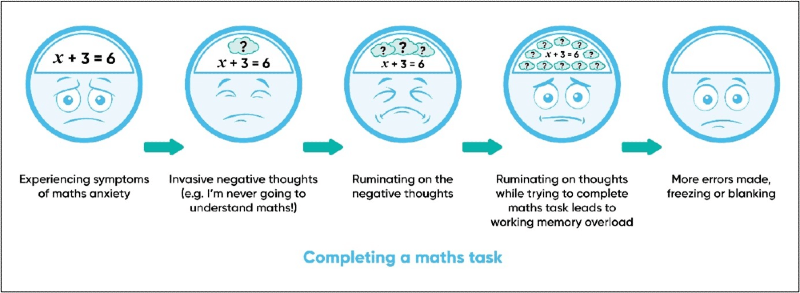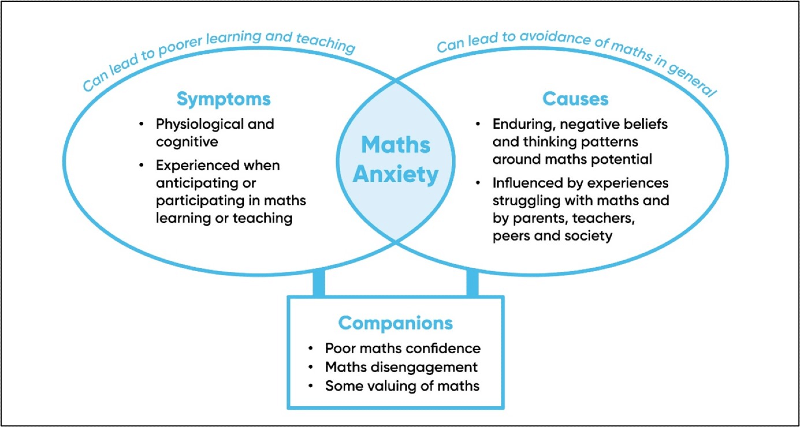What Is Mathematics Anxiety Pdf
Mathematics anxiety
Page Content
This research is focussed on helping teachers and school leaders gain a better understanding of how mathematics anxiety negatively impacts learning and teaching.
Download this monograph
The big picture
"Many people think of mathematics as one of the most logical, most impersonal branches of knowledge, yet it inspires more emotion than any other school subject" (Zaslavsky, 1994, p.5).
Teachers of English, Art and other disciplines would argue with Zaslavsky that their content also inspires a range of emotions in students. However, there is a difference for mathematics that Zaslavsky alludes to – the emotion is often negative and can be extreme. Mathematics anxiety, the worry and tension felt when anticipating or completing mathematical tasks, is reported widely by Australian students (Thomson, DeBortoli & Buckley, 2013). This Mathematics Monograph is focussed on helping teachers and school leaders gain a better understanding of:
- How mathematics anxiety negatively impacts learning and teaching.
- The symptoms, causes and companions of mathematics anxiety.
- The difference between reducing mathematics anxiety directly and indirectly.
- Strategies that can identify and address mathematics anxiety in students and teachers.
This research is intended to present information for reflecting and planning how mathematics anxiety can be reduced and regulated in classrooms and in the school community.
The impact of mathematics anxiety on mathematics performance
Mathematics anxiety is widely studied for its negative impact on learning.

Figure 1: Long description
This figure illustrates a sequence of five faces, presented as a modified emoji that includes a space for a face, and above it a space that represents the brain. An arrow between each face form a trajectory of rising concern.
The first face shows a worried expression, where the individual is experiencing symptoms of maths anxiety, with the brain component showing x + 3 = 6.
The next emoji demonstrates the impact of invasive negative thoughts, with a question mark in the brain noting "I'm never going to understand maths".
The third emoji, follows on with the face showing more worry, as the individual is ruminating on the negative thoughts, depicted by lots of question marks in the brain.
The fourth picture demonstrates memory overload, with the face ruminating further on thoughts while trying to complete a maths task. The final face shows a blank look, showing that this individual being confused and dumbfounded with a frozen and blank look on its face.
Research has demonstrated that mathematics anxiety can interrupt working memory leading to more error-making and reducing the capacity to successfully participate in mathematics (see Figure 1; Ashcraft & Kirk, 2001; Eden, Heien & Jacobs, 2013; Ma, 1999).
Individuals who consistently experience mathematics anxiety when engaging with mathematics are more likely to avoid mathematics subjects, courses and careers. Therefore, mathematics anxiety is a problem for short-term learning as it compromises performance and a problem for long-term learning as it leads students away from mathematics opportunities and career pathways (Buckley, Reid, Good, Lipp & Thomson, 2016).
Compounding the problem even further, mathematics anxiety is a common phenomenon in mathematics classrooms. For instance, in the 2012 cycle of PISA, 25 per cent of Australian 15-year-old students reported feeling helpless when doing a mathematics problem (Thomson, DeBortoli & Buckley, 2013).
Mathematics anxiety can also be an obstacle for mathematics teaching. Teachers who experience higher levels of mathematics anxiety are less confident and more likely to avoid teaching mathematics when given the option (Gresham, 2018). While no population-level studies have been conducted, researchers estimate anywhere between 6-17% of the population experience mathematics anxiety (Dowker, Sarkar & Looi, 2016).
One way to better understand mathematics anxiety is to think about it having symptoms, causes and companions. The symptoms and causes have different impacts on learning and need different strategies to address them (Buckley, Reid, Good, Lipp & Thomson, 2016), while the companions are things often experienced alongside mathematics anxiety (see Figure 2).
Symptoms, causes and companions of mathematics anxiety

Symptoms are:
- physiological (including increased heart rate and breathing rate) and cognitive (invasive negative thoughts or worries, e.g. 'I am never going to understand maths').
- felt when anticipating or completing a mathematics task.
- the part of mathematics anxiety that can lead to poorer performance on mathematics tasks; however, this depends on how the symptoms are managed. Research suggests that students who use emotion regulation skills to moderate the symptoms of their mathematics anxiety are able to eliminate or reduce the negative impact of those symptoms on their mathematics performance and learning (Ramirez, Shaw & Maloney, 2018).
The causes of mathematics anxiety:
- Revolve around a fixed mindset or belief about mathematics performance and learning - "I am no good at maths"; "My parents were bad at maths and that's why I am too"; "I'm just not a maths person". All of these statements illustrate a belief that mathematics potential cannot change. Students who believe that their mathematics potential is fixed are unlikely to think that effort or practise in mathematics is going to improve their mathematics learning.
- Are beliefs that are long-standing and formed through experiences with parents, teachers and peers. They are also influenced by previous experiences struggling with mathematics (Buckley, Reid, Good, Lipp & Thomson, 2016).
- Can be addressed by changing and challenging negative beliefs about mathematics ability (Paunesku, Walton, Romero, Smith, Yeager & Dweck, 2015).
The companions of mathematics anxiety include:
- Poor mathematics confidence
- Mathematics disengagement
- Some type of valuing of mathematics
You cannot be anxious about something unless you value it and value can come in different forms. Value could be liking or enjoying mathematics, it could be seeing mathematics as useful for life or career options, or it could be thinking that mathematical knowledge is related to general intelligence.
Issues and challenges in addressing mathematics anxiety in schools
Cultural challenges
Negative perceptions and attitudes towards mathematics in the community mean that mathematics anxiety has become an accepted emotional response in reaction to mathematics content (Wilkins, 2000). Peer relationships, networks and social identities, particularly in early adolescence, can be based around openly disliking and avoiding mathematics (Frenzel, Pekrun & Goetz, 2007). Parental attitudes can also be the source or reinforce a fixed mathematics mindset. One of the ways to address negative mathematics culture is by highlighting role models in the community or in fiction that challenge negative stereotypes about mathematics. For example, some that could be discussed are Tony Stark (aka Iron Man) or Michael Jordan who studied mathematics at university.
Conceptual challenges
Mathematics anxiety is a popular topic of discussion in mathematics teaching for good reason; however, this discussion always centres on the negative qualities of anxiety. A way to reframe mathematics anxiety is to acknowledge its positive and constructive qualities. One of these has already been discussed and that is recognising that mathematics anxiety can only be experienced by someone who values mathematics in some way; someone who does not value mathematics feels apathy and not anxiety. The other positive quality to appreciate is that moderate levels of anxiety are associated with optimal levels of performance. When it is emphasised to students that moderate anxiety actually leads to performance improvement, research has shown that students do better on mathematics tasks (Jamieson, Peters, Greenwood, Altose, 2016).
Throughout this Mathematics Monograph there is discussion of reducing and regulating mathematics anxiety. This phrasing is intentional and designed to challenge educators to think that the objective is not to remove all mathematics anxiety but to reduce and regulate anxiety so that it is operating at a level that leads to the best mathematics performance and learning.
Pedagogical challenges
In many classrooms, the way that mathematics anxiety is targeted is indirect. Educators often aim to reduce anxiety by improving mathematics confidence and building students' mathematical understanding. The assumption is that after confidence improves, anxiety will decrease. However, this does not work for all students and when it is effective it does not always reduce mathematics anxiety in the long-term. Research suggests direct or psychological strategies should be used in combination with indirect or educational strategies to successfully reduce mathematics anxiety (Bursal, Paznokas, 2006; Maloney, Schaeffer & Beilock, 2013). This idea may seem counterintuitive but it links to a symptoms-and-causes model of mathematics anxiety:
- the symptoms of mathematics anxiety should be addressed by helping students improve their emotion regulation skills to remove anxiety as a barrier to mathematical learning; and,
- the causes of mathematics anxiety should be addressed by using pedagogical practices that foster a growth mindset, challenge negative thinking about mathematics and provide students with the opportunity for personal mathematics accomplishment.
Key terms and definitions
Working memory
Part of the memory system that is crucial for mathematical learning as it allows information to be temporarily stored, maintained and manipulated (Ashcraft & Kirk, 2001; Clements, Sarama & Germeroth, 2016).
Emotion regulation
The process of changing the way that an emotion is experienced by altering things like its strength, how it is expressed or its type (e.g. reframing a negative emotional experience to become positive) (Davis & Levine, 2013).
What Is Mathematics Anxiety Pdf
Source: https://www.education.vic.gov.au/school/teachers/teachingresources/discipline/maths/Pages/research_overcomingmathsanxiety.aspx
Posted by: gilliamwough1983.blogspot.com

0 Response to "What Is Mathematics Anxiety Pdf"
Post a Comment